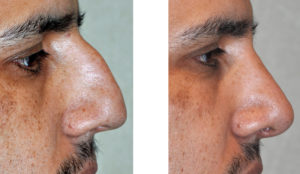
Fortunately, complications from rhinoplasty are uncommon and usually minor. But the issues of bleeding, undesired shape and irregularities, and difficulties with breathing constitute the most undesireable outcomes.
Because the nose has so many blood vessels, the risk of bleeding after surgery is very real. Usually this risk is more significant when surgery is done on the inside of the nose for breathing purposes at the same time. The tapes and splint on the outside of the nose helps eliminate space under the skin where even minor amounts of blood can collect. Blowing one’s nose is the most common cause of bleeding so this should be avoided. I generally don’t use packing for rhinoplasty unless there is uncontrolled bleeding during surgery. The bleeding risk will exist for several weeks after surgery so don’t be tempted to blow your nose!
Infections after rhinoplasty are very uncommon. This risk is increased when a synthetic material or implant is used as part of the rhinoplasty. Here the many blood vessels of the nose are very beneficial as they bring cells that help fight infection as well as antibiotics throughout all areas of the nose. When the materials used to reshape and rebuild the nose are natural (e.g., cartilage), the risk of infection is less than 1%.
Asymmetry or an undesired shape or area is the most common adverse side effect from rhinoplasty in my experience. This occurs often because of factors that go beyond the control of the plastic surgeon. An abnormal shape of the nose can occur from a large variety of reasons such as how the procedure was technically done, shifting of cartilage reshaping due to sutures slipping afterwards, excessive scar that forms under one area of the skin, bleeding after surgery, shifting of the tapes and splint, and bumping or trauma to the nose in the first few weeks after surgery.
As a result of these potential complications, some patients will need secondary or revisional rhinoplasty surgery. I have seen varying reports that range from 10% to 15% of people who had rhinoplasty needed follow- up surgical operations. For this reason, every patient should have a good awareness of these risks and what will be done in the event that they do occur.
Dr. Barry Eppley
Indianapolis, Indiana


